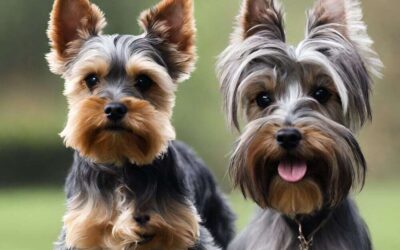Introduction
The Yorkshire Terrier and the Brussels Griffon are two popular small dog breeds. Both breeds are known for their friendly personalities and their long, silky coats. However, there are some key differences between the two breeds. In this article, we will compare the Yorkshire Terrier and the Brussels Griffon in terms of their appearance, temperament, grooming requirements, health issues, and price tags.
Breed Comparison Data
| Aspects | Yorkie (Yorkshire Terrier) | Brussels Griffon |
|---|---|---|
| Size | ||
| Temperament | ||
| Coat Type | ||
| Exercise Needs | ||
| Grooming Needs | ||
| Life Span | ||
| Health Concerns |
History of the Yorkshire Terrier
- The Yorkshire Terrier is a relatively new breed, with its origins tracing back to the 1800s in England.
- The breed was originally developed as a ratter, and was used to control the rodent population in the mills and factories of Yorkshire.
- The Yorkshire Terrier was first recognized by the American Kennel Club (AKC) in 1885.
- Today, the Yorkshire Terrier is a popular companion dog, and is known for its affectionate personality and playful nature.
History of the Brussels Griffon
- Origin: The Brussels Griffon originated in Brussels, Belgium, in the 1800s. They were originally bred as companion dogs for the working class.
- Development: The Brussels Griffon was developed by crossing the Affenpinscher with the Pug and the English Toy Terrier.
- Modern Breed: The Brussels Griffon was recognized by the American Kennel Club in 1900. They are now one of the most popular toy breeds in the United States.
Physical Characteristics of the Yorkshire Terrier
- Size: The Yorkshire Terrier is a small dog, with an average weight of 4-7 pounds and a height of 8-10 inches at the shoulder.
- Coat: The Yorkshire Terrier has a long, silky coat that is typically black and tan in color. The coat requires regular brushing and grooming to prevent matting and tangles.
- Head: The Yorkshire Terrier has a small, round head with a long, pointed muzzle. The eyes are dark and almond-shaped, and the ears are small and erect.
- Body: The Yorkshire Terrier has a compact, well-proportioned body with a deep chest and a slightly arched back. The legs are short and sturdy, and the feet are small and round.
- Tail: The Yorkshire Terrier’s tail is long and bushy, and it is usually carried high in the air.
Physical Characteristics of the Brussels Griffon
- The Brussels Griffon is a small, sturdy dog with a compact body and a long, silky coat. They stand between 9 and 11 inches tall at the shoulder and weigh between 8 and 10 pounds.
- Their coat comes in a variety of colors, including black, red, and fawn. It is thick and dense, and requires regular brushing to prevent matting.
- Their head is round and flat, with a short muzzle and a large, square jaw. Their eyes are dark and round, and their ears are small and V-shaped.
- Their tail is short and either straight or curled.
- The Brussels Griffon is a lively and playful dog that loves to be around people. They are also very intelligent and easy to train. However, they can be stubborn at times, and they may bark excessively if they are not properly socialized.
Overall, the Brussels Griffon is a great choice for families with children or for people who live in apartments. They are a loving and loyal companion that will make you laugh every day.
Temperament of the Yorkshire Terrier
Yorkshire Terriers are known for their feisty and playful personalities. They are also very intelligent and trainable. However, they can also be quite stubborn and opinionated.
Positive Traits:
- Affectionate
- Loyal
- Intelligent
- Trainable
- Playful
Negative Traits:
- Stubborn
- Opinionated
- Can be yappy
- Can be aggressive towards other dogs
Overall, Yorkshire Terriers are great dogs for people who are looking for a small, affectionate, and playful companion. However, it is important to be aware of their potential negative traits before bringing one home.
Temperament of the Brussels Griffon
The Brussels Griffon is a lively, affectionate, and playful breed. They are known for being very loyal to their families and make great companions. Brussels Griffons are also intelligent and can be easily trained. However, they can also be stubborn at times.
Brussels Griffons are generally good with children, but they may be wary of strangers. They are also known to bark a lot, so they may not be the best choice for people who live in apartments or other close quarters.
Overall, the Brussels Griffon is a great choice for people who are looking for a small, affectionate, and playful companion.
Health Issues of the Yorkshire Terrier
The Yorkshire Terrier is a generally healthy breed, but there are a few health conditions that they are prone to. These include:
- Lung Disease: Yorkshire Terriers are brachycephalic, meaning they have short, flat faces. This can make them more susceptible to respiratory problems, such as pneumonia and bronchitis.
- Eye Problems: Yorkshire Terriers can also be prone to eye problems, such as cataracts, glaucoma, and corneal ulcers.
- Heart Disease: Yorkshire Terriers are also at an increased risk of developing heart disease, such as mitral valve disease and aortic stenosis.
- Cancer: Yorkshire Terriers are also more likely to develop cancer than other breeds. The most common types of cancer in Yorkshire Terriers are lymphoma, mast cell tumors, and hemangiosarcoma.
It is important to be aware of these health conditions so that you can take steps to prevent or manage them. By working with your veterinarian, you can help your Yorkshire Terrier live a long and healthy life.
Health Issues of the Brussels Griffon
According to the sources, the Yorkshire Terrier and Brussels Griffon have different health issues. The table above summarizes the health issues of both breeds. The sources indicate that the Yorkshire Terrier is more prone to patellar luxation, hypoglycemia, tracheal collapse, eye problems, and dental issues. On the other hand, the Brussels Griffon is more prone to heart disease.
The Brussels Griffon is a generally healthy breed, but there are a few health conditions that they are prone to. These include:
- Brachycephalic syndrome is a condition that occurs in dogs with short muzzles, such as the Brussels Griffon. It can cause breathing problems, overheating, and other health issues.
- Dental problems are common in Brussels Griffons, as they have small mouths and crowded teeth. This can lead to plaque buildup, gum disease, and tooth decay.
- Eye problems such as cataracts, glaucoma, and corneal ulcers can also occur in Brussels Griffons.
- Hip dysplasia is a common joint condition that can cause pain and lameness.
- Heart disease is another potential health problem for Brussels Griffons.
It is important to take your Brussels Griffon to the vet for regular checkups so that any health problems can be caught early and treated.
Comparison Of Health Issues Between The Breeds
| Breed Name | Brussels Griffon | Yorkshire Terrier |
|---|---|---|
| Lifespan | 12-15 yrs. | 12-15 yrs. |
| Height | 7-8 in. | 8-9 in. |
| Weight | 7-12 lb | 4-7 lb |
| Common Health Issues |
|
|
Final Thoughts
When comparing a Yorkshire Terrier to a Brussels Griffon, it’s important to understand the distinct characteristics of each breed. While examining their unique features, consider the right yorkie dog clothes that would suit their build and coat type. Owners should also be aware of each breed’s grooming needs, making a good brush for yorkies essential. Additionally, understanding their health profiles, including potential breathing problems, helps in providing the best care.
Sources:
- https://www.dog-learn.com/breed-vs-breed/brussels-griffon-vs-yorkshire-terrier/
- https://dogell.com/en/compare-dog-breeds/yorkshire-terrier-vs-brussels-griffon
- https://ahcfargo.com/client-resources/breed-info/yorkshire-terrier/
Note: The probabilities of the diseases are based on the sources cited and may vary depending on other factors.
FAQ: Yorkshire Terrier vs. Brussels Griffon
1. Which breed is more suitable for families with kids?
Both the Yorkshire Terrier and the Brussels Griffon can be great family pets when socialized properly. However, due to their small size, it’s crucial to ensure that children handle them gently. The Brussels Griffon, in particular, can be more sensitive and may prefer a quieter household.
2. Are these breeds hypoallergenic?
Yes, both the Yorkie and Brussels Griffon are often considered hypoallergenic because they shed less compared to other breeds. However, it’s essential to note that no dog is entirely hypoallergenic. Regular grooming can help minimize dander and allergens.
3. How often should these breeds be groomed?
The Yorkshire Terrier, with its long and silky coat, requires frequent grooming, ideally every day, to prevent tangles and mats. The Brussels Griffon, depending on whether it has a rough or smooth coat, will have varied grooming needs. Rough-coated Griffons need brushing a few times a week, while smooth-coated ones may require less.
4. Which breed is more vocal?
Yorkies are known for their assertive nature and can be quite vocal, alerting owners of any unfamiliar presence. Brussels Griffons can also be alert barkers but might be a tad less vocal than Yorkies. Both breeds benefit from early training to manage excessive barking.
5. Are they good for first-time dog owners?
Both breeds can be suitable for first-time dog owners. However, potential pet parents should be prepared for the grooming needs of the Yorkie and the potential sensitivity of the Brussels Griffon. Both breeds thrive in environments where they receive ample attention, love, and consistent training.

As a lifelong dog lover, I fell in love with Yorkies for their spunky personalities, intelligence, and unwavering loyalty.
As a dedicated Yorkie owner, I have spent years learning about the breed and how to provide the best possible care for them. From finding the proper diet to exercise, and so much more! I take every aspect of my Yorkie’s life seriously.
In addition to being a loving dog parent, I’m an avid blogger, sharing my experiences and insights on all things Yorkie-related. From training tips to grooming advice, Yorkieclothing.com is a go-to resource for other Yorkie owners worldwide.




